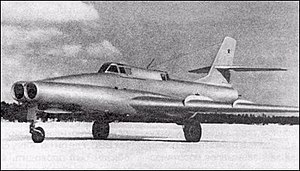Ilyushin Il-40
| Il-40 | |
|---|---|
 |
|
| Ilyushin Il-40P, the second prototype | |
| Role | Ground-attack aircraft |
| National origin | Soviet Union |
| Manufacturer | Ilyushin |
| First flight | 7 March 1953 |
| Status | Prototype |
| Number built | 7 |
The Ilyushin Il-40 (NATO reporting name: Brawny) was a two-seat Soviet jet-engined armored ground-attack aircraft. The first prototype flew in 1953 and was very successful except when it fired its guns, as their combustion gasses disturbed the airflow into the engines and caused them to flameout or hiccup. Remedying this problem took over a year and involved the radical change of moving the engine air intakes all the way to the very front of the aircraft and repositioning the guns from the tip of the nose to the bottom of the fuselage, just behind the nosewheel. The aircraft, now resembling a double-barreled shotgun from the front, was ordered into production in 1955. Only five production aircraft had been completed before the entire program was canceled in early 1956 when the VVS discarded its close air-support doctrine in favor of tactical nuclear weapons on the battlefield.
Sergey Ilyushin had begun design studies during 1950–51 for a jet-engined ground-attack aircraft possessing better performance characteristics than was possible with piston-engined aircraft. By the end of 1951 the Ilyushin design bureau had prepared a technical proposal for a two-seat armored aircraft using two Mikulin AM-5 axial-flow turbojets rated at 2,150 kgf (4,740 lbf) at maximum power (without afterburner) and 2,700 kgf (5,952 lbf) with afterburner. In January 1952 Ilyushin sent this proposal to the government, which was quickly accepted, and he was directed to design and build one prototype.
The Il-40 had wings set low on the fuselage, swept back at an angle of 35°, and a tricycle undercarriage. The two AM-5 engines were in pods adjacent to the fuselage. As was traditional for Ilyushin ground-attack aircraft, the core of Il-40's structure was a load-bearing armored shell that protected both crew positions, six fuel tanks and part of the radio and electrical equipment. The thickness of the shell ranged from 3 to 8 mm (0.12 to 0.31 in) in thickness. The armored bulkhead protecting the pilot from the front was 10 mm (0.39 in) thick. The cockpit glazing was also bulletproof and the pilot was given an 8 mm (0.31 in) armored headrest to protect him against shells fired from above and behind. The gunner was protected by armor 4–10 mm (0.16–0.39 in) thick. The total weight of the armored shell and the bulletproof glass was 1,918 kg (4,228 lb). Ejection seats were provided for both crewmembers. Three perforated airbrakes were fitted on the rear fuselage, one on each side and one underneath, to enhance the aircraft's maneuverability during a dive.
...
Wikipedia
